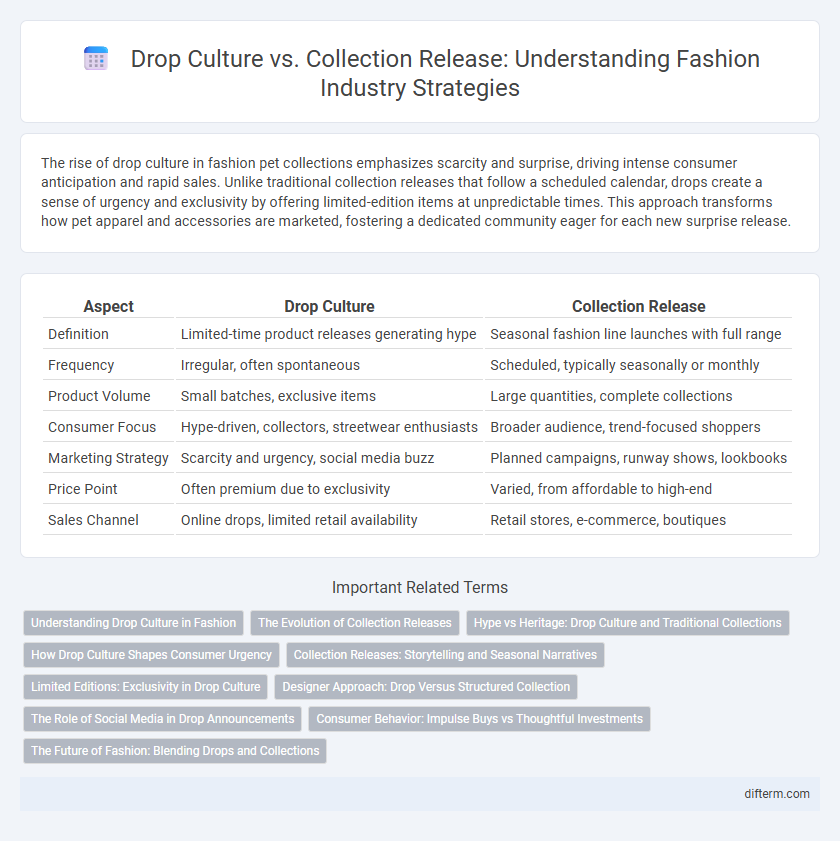The rise of drop culture in fashion pet collections emphasizes scarcity and surprise, driving intense consumer anticipation and rapid sales. Unlike traditional collection releases that follow a scheduled calendar, drops create a sense of urgency and exclusivity by offering limited-edition items at unpredictable times. This approach transforms how pet apparel and accessories are marketed, fostering a dedicated community eager for each new surprise release.
Table of Comparison
| Aspect | Drop Culture | Collection Release |
|---|---|---|
| Definition | Limited-time product releases generating hype | Seasonal fashion line launches with full range |
| Frequency | Irregular, often spontaneous | Scheduled, typically seasonally or monthly |
| Product Volume | Small batches, exclusive items | Large quantities, complete collections |
| Consumer Focus | Hype-driven, collectors, streetwear enthusiasts | Broader audience, trend-focused shoppers |
| Marketing Strategy | Scarcity and urgency, social media buzz | Planned campaigns, runway shows, lookbooks |
| Price Point | Often premium due to exclusivity | Varied, from affordable to high-end |
| Sales Channel | Online drops, limited retail availability | Retail stores, e-commerce, boutiques |
Understanding Drop Culture in Fashion
Drop culture in fashion revolutionizes traditional collection releases by delivering limited-edition items in small batches to create urgency and exclusivity. Brands leveraging this strategy boost consumer engagement through hype-driven marketing, often involving surprise announcements and collaborations. This method contrasts with seasonal collections by emphasizing scarcity and immediacy, aligning with the fast-paced digital shopping environment.
The Evolution of Collection Releases
The evolution of collection releases in fashion reflects a shift from traditional seasonal launches to drop culture, where limited-edition pieces are released frequently to create urgency and exclusivity. Brands leverage social media and influencer marketing to generate hype and instant consumer engagement with each drop. This transformation prioritizes speed and scarcity, challenging the conventional calendar-based collection system.
Hype vs Heritage: Drop Culture and Traditional Collections
Drop culture thrives on creating immediate hype through limited, time-sensitive releases that generate urgency and exclusivity, often driven by social media buzz and influencer endorsements. Traditional collection releases emphasize heritage and craftsmanship, showcasing seasonal designs that reflect a brand's legacy and long-term vision. This contrast highlights how drop culture prioritizes rapid engagement and trend responsiveness, while traditional collections foster enduring brand identity and consumer loyalty.
How Drop Culture Shapes Consumer Urgency
Drop culture in fashion leverages limited-time product availability to create a heightened sense of urgency, driving consumers to make quicker purchasing decisions. Brands employing drop culture strategically generate hype through social media teasers and countdowns, amplifying scarcity and desirability. This approach contrasts traditional collection releases by prioritizing immediacy and exclusivity, fostering stronger consumer engagement and boosting sales velocity.
Collection Releases: Storytelling and Seasonal Narratives
Collection releases in fashion emphasize storytelling and seasonal narratives that create a cohesive brand identity, allowing designers to convey inspiration and trends through curated garments. Each collection reflects a thematic journey, often aligning with cultural moments or shifts, enhancing consumer engagement and emotional connection. Seasonal cycles guide the evolution of designs, making collections a strategic tool for sustained market presence and artistic expression.
Limited Editions: Exclusivity in Drop Culture
Limited edition drops create a sense of exclusivity by releasing a small quantity of highly coveted fashion items, driving immediate demand and consumer urgency. Unlike traditional collection releases that follow seasonal schedules, drop culture leverages scarcity and surprise to amplify brand desirability and boost resale value. This strategy cultivates a loyal customer base eager to secure unique pieces before they disappear, reinforcing the brand's cultural relevance.
Designer Approach: Drop Versus Structured Collection
Designer approaches in fashion vary between the drop culture and structured collection release. Drop culture emphasizes spontaneity and limited-edition pieces, creating scarcity and immediate consumer engagement through frequent, small releases. Structured collections follow traditional seasonal cycles, allowing designers to build cohesive narratives, showcase craftsmanship, and align with industry events like fashion weeks.
The Role of Social Media in Drop Announcements
Social media platforms like Instagram, TikTok, and Twitter play a pivotal role in drop culture by enabling brands to create hype and sudden exclusivity around limited releases. Real-time engagement and influencer collaborations amplify drop announcements, driving immediate consumer action and FOMO (fear of missing out). This dynamic contrasts with traditional collection releases, which rely on planned schedules and longer promotional cycles.
Consumer Behavior: Impulse Buys vs Thoughtful Investments
Drop culture drives consumer behavior toward impulse buys by creating urgency and exclusivity, prompting immediate purchases based on fear of missing out (FOMO). In contrast, traditional collection releases encourage thoughtful investments, as shoppers have more time to evaluate designs, price points, and overall value before committing. This shift influences brand strategies, as drops prioritize limited quantities and rapid sales, while collections focus on sustained engagement and brand loyalty.
The Future of Fashion: Blending Drops and Collections
The future of fashion merges the immediacy of drop culture with the curated depth of traditional collections, creating a dynamic retail experience that caters to both hype-driven consumers and classic fashion enthusiasts. Brands leveraging data analytics and social media trends optimize drop timings to maximize engagement while maintaining seasonal collections that offer cohesive storytelling and timeless appeal. This hybrid model enhances consumer loyalty and drives sustained growth by balancing scarcity with accessibility in a fast-evolving market.
drop culture vs collection release Infographic

 difterm.com
difterm.com